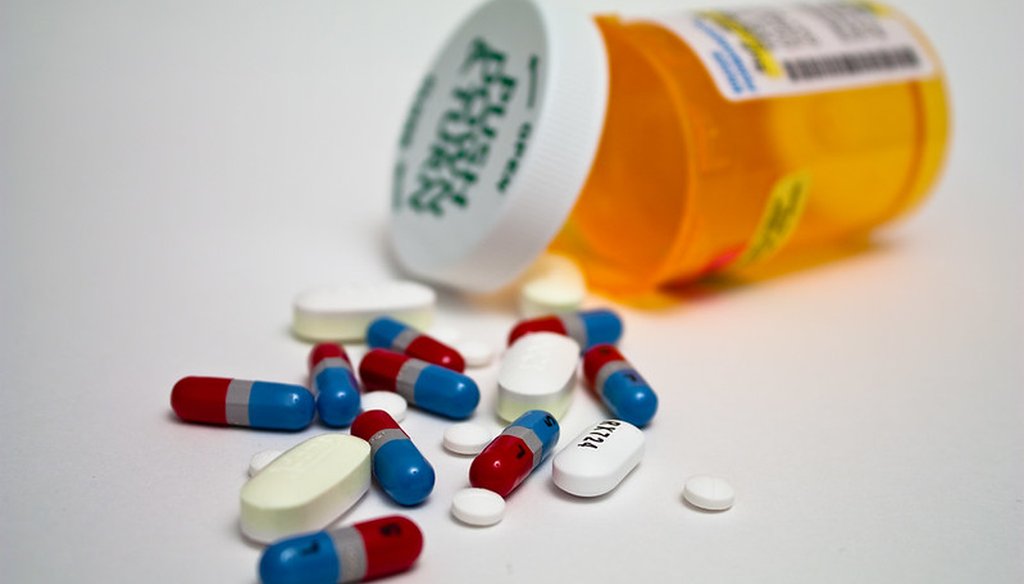

Our only agenda is to publish the truth so you can be an informed participant in democracy.
We need your help.


Prescription drugs subject to abuse. (ed_jhu, via Flickr Creative Commons License)
The average annual cost of prescription drug treatment increased 26.3% between 2015 and 2019, according to the AARP.
U.S. Census Bureau data shows the median income for Wisconsin residents went fom $55,638 in 2015 to $64,168 in 2019, an increase of 15.3%.
But the increase for Wisconsin residents age 50 and older increased 13.9%, so Godlewski was generally on target.
Prescription drug costs in the United States have long been a hot-button issue for voters.
On July 9, 2021, Joe Biden signed an executive order aimed at enacting "aggressive legislative reforms" that would lower prescription drug prices. He had pledged to do so on the campaign trail.
In Wisconsin, State Treasurer Sarah Godlewski, a Democratic candidate for U.S. Senate, has struck a similar theme. She hopes to face U.S. Sen. Ron Johnson, a Republican, in November 2022.
"The skyrocketing cost of prescription drugs plagues Wisconsinites and harms Americans in every corner of the country. As pharmaceutical companies pull in record profits, folks are skipping pills to make their prescriptions last a little longer, while others are having to choose between their groceries and their life-saving medicine," Godlewski said in a Feb. 18, 2022 campaign statement "Here in Wisconsin, prescription drug costs grew at a pace of nearly twice as much as the average Wisconsinite's income from 2015-2019."
The final part of Godlewski’s claim caught our attention.
Have prescription drug costs grown at a pace of nearly twice as much as the average Wisconsinite's income?
Let’s take a look.
When asked for backup to Godlewski’s claim, her campaign staff cited an AARP article title "Prescription Drug Costs are Rising Nearly Twice as Fast as Wisconsinites’ Income." AARP is a nonprofit, nonpartisan organization active on issues that affect people age 50 and over.
The average annual cost of prescription drug treatment increased 26.3% between 2015 and 2019, while the annual income for Wisconsin residents only increased 13.9%," AARP reported.
But a check of the U.S. Census Bureau’s American Community Survey shows that the median income for Wisconsin residents increased 15.2%, from $55,638 in 2015 to $64,168 in 2019.
Why the discrepancy?
The 13.9% increase applies to residents over the age of 50, while the 15.3% increase applies to all residents.
So, Godlewski was generally on target, but overshot the mark a bit in her phrasing.
In Wisconsin, according to the 2020 "Governor’s Task Force on Reducing Prescription Drug Prices", prescription drugs were estimated to cost residents more than $1.3 billion overall in 2019.
Meanwhile, an AARP graphic – "Impact of High Rx Prices to Wisconsin Residents" – looked at the increase in price for three specific medications between 2015-2020:
Revlimid, a cancer treatment, went from $185,574 to $267,583, up 44%
Victoza, a diabetes treatment, went from $7,936 to $11,300, up 42%
Spiriva inhaler, used for asthma and COPD, went from $3,886 to $5,289, up 36%
The report went on to state that retail prices for 76% of the most widely used brand name prescription drug products (198 of 260) had price increases in 2020 – and 92% of these price increases (183 of 198) were greater than the rate of general inflation in 2002, which was 1.3%.
Separately, a Feb. 25, 2022 report by the Kaiser Family Foundation, a nonprofit organization focusing on national health issues, found prices increased faster than inflation for half of all drugs covered by Medicare in 2020.
Godlewski said "in Wisconsin, prescription drug costs grew at a pace of nearly twice as much as the average Wisconsinite's income from 2015-2019."
The average annual cost of prescription drug treatment increased 26.3% in that time frame. The increase in income for all Wisconsin residents was actually 15.2%. The figure Godlewski was citing is for those age 50 and over, whose income increased 13.9%.
For a statement that is accurate but needs clarification or additional information, our rating is Mostly True.
Sarah Godlewski, statement "SARAH GODLEWSKI’S PLAN TO REIN IN DRUG COSTS & HOLD BIG PHARMA ACCOUNTABLE," Feb. 18, 2022
Email, Lisa Lamkins| Advocacy Director – Federal Issues, AARP Wisconsin, Feb. 28, 2022
AARP WisconsinThe White House, "Promoting Competition in the American Economy," July 9, 2021
U.S. Census Bureau, American Community Survey, "Household Income 2015"
U.S. Census Bureau, American Community Survey, "House Income 2019"
"Governor’s Task Force on Reducing Prescription Drug Prices" 2020
AARP "Prescription Drug Price Increases Continue to Outpace Inflation," June 7, 2021
AARP "Trends in Retail Prices of Brand Name Prescription Drugs Widely Used by Older Americans, 2006 to 2020" June 2021
Kaiser Family Foundation "Prices Increased Faster Than Inflation for Half of all Drugs Covered by Medicare in 2020," Feb. 25, 2022.
In a world of wild talk and fake news, help us stand up for the facts.
